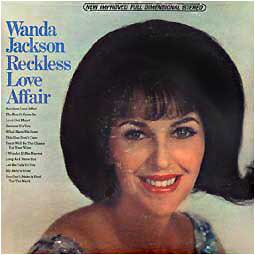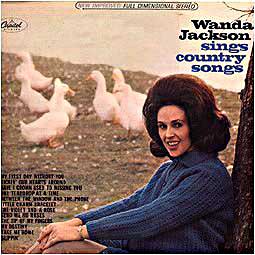


WANDA JACKSON
Wanda Jackson was
only halfway through high school when, in 1954, country singer Hank Thompson
heard her on an Oklahoma City radio show and asked her to record with his band,
the Brazos Valley Boys. By the end of the decade, Jackson had become one of
America's first major female country and rockabilly singers.
Jackson was born in Oklahoma, but her father moved the family to California in
1941. He bought Wanda her first guitar two years later, gave her lessons, and
encouraged her to play piano as well. In addition, he took her to see such acts
as Tex Williams, Spade Cooley, and Bob Wills, which left a lasting impression on
her young mind. He moved the family back to Oklahoma City when his daughter was
12 years old. In 1952, she won a local talent contest and was given a 15-minute
daily show on KLPR. The program lasted throughout Jackson's high school years.
It's here that Thompson heard her sing. Jackson recorded several songs with the
Brazos Valley Boys, including "You Can't Have My Love," a duet with Thompson's
bandleader, Billy Gray (#8 in the charts).
Jackson insisted on finishing high school before hitting the road. Her mother
helped to design Wanda's stage outfits. "I was the first one to put some glamour
in the country music — fringe dresses, high heels, long earrings," Jackson said
of these outfits. When Jackson first toured in 1955 and 1956, she was placed on
a bill with none other than Elvis Presley. Jackson said it was Presley, along
with her father, who encouraged her to sing rockabilly.
In 1956, Jackson finally signed with Capitol, a relationship that lasted until
the early '70s. Her recording career bounced back and forth between country and
rockabilly; she did this by often putting one song in each style on either side
of a single. Jackson cut the rockabilly hit "Fujiyama Mama" in 1958, which
became a major success in Japan. Her version of "Let's Have a Party," which
Elvis had cut earlier, was a U.S. Top 40 pop hit for her in 1960, after which
she began calling her band the Party Timers. A year later, she was back in the
country Top Ten with "Right or Wrong" and "In the Middle of a Heartache". In
1966, she hit the U.S. Top 20 with "The Box It Came In" and "Tears Will Be the
Chaser for Your Wine". She continued to appear on the country charts, with
moderate success only, until 1974.


